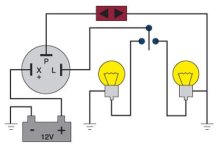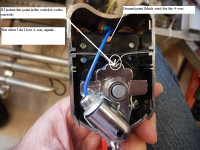j bjork
1 MW
I suppose the outer ring of contacts is for the brake light.
The purpose is when the switch is in off position it will lead from the red to the question marks, and then to the rear right and left lamp. If the switch is to the right it will only lead brake light to the rear left lamp. And the other way around.
The inner ring is for the for the flasher, and should then lead from the black to the left or right lamps if the switch is to the left or right. The black cant be ground in that case, it have to be output from the flasher relay.
The purpose is when the switch is in off position it will lead from the red to the question marks, and then to the rear right and left lamp. If the switch is to the right it will only lead brake light to the rear left lamp. And the other way around.
The inner ring is for the for the flasher, and should then lead from the black to the left or right lamps if the switch is to the left or right. The black cant be ground in that case, it have to be output from the flasher relay.






